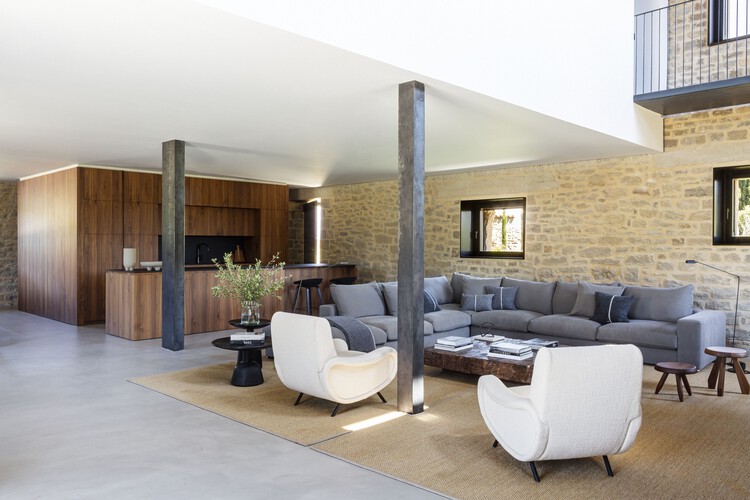
-
Architects: Lourdes Martínez Nieto Arquitectura y Diseño
- Area: 450 m²
- Year: 2020
-
Photographs:Belén Imaz
-
Manufacturers: Dornbracht, Hoppe, Uponor, Santa & Cole, CB2 New York, Cassina, De Dietrich, Flex Form, Fontini, Formani, Gunni&Trentino, Hee Welling & Hay, Inalco, KP, Knoll International, LUMİNA, Naturamia, Neff, Pando, Teixidors, +4
_(72dpi)_ok.jpg?1650936003)
Text description provided by the architects. This project consists of the full refurbishment of a 16th-century farmhouse located on the top of a hill in Muruzábal de Andión, Navarra, Spain. In a captivating environment due to its impressive historical value as a result of the ensemble, it forms with the Romanesque hermitage and the roman stela embedded in the facade.
_(72dpi)_ok.jpg?1650936084)
_(72dpi)_ok.jpg?1650936024)
The farmhouse only held on to the skin, a shell of stone masonry that houses an empty interior. The client’s premise was to provide light to the inside, due to the lack of it, because of the thickness of the walls and the position of the hollows. The concept follows this need; therefore, two large-scale and spacious voids were proposed, they organize the space and its uses, while being capable of redirecting the light everywhere.
_(72dpi)_ok.jpg?1650936105)
_(72dpi)_ok.jpg?1650936110)
The main void consists of the spatial opening of three heights, which arrange the living area on the ground floor and organizes the connexions between spaces. The secondary void occupies two heights and it’s opposed to the main one, creating a lounge area with major privacy. From the main void rises the transition from public to private spaces. This is achieved by generating volumes, which are arranged like a matryoshka, “one inside the other”.
_(72dpi)_ok.jpg?1650936087)
The main volume materializes as a suspended box in the space, white and sober, emphasizing the colonization of a new element within that existing shell of stone while being able to reflect the light. Inside this volume, we find wooden boxes and the second volume.
_(72dpi)_ok.jpg?1650936062)
The materiality of the whole house responds to this concept. The rusticity of the existing stone in the building skin as opposed to the purity of the suspended white volume. Masonry is the protagonist in public spaces, while private ones are characterized by its absence and the presence of oak wood in the same tone as the stone.

The elements that do not belong to either of these two “worlds” are distinguished by being noble materials while maintaining the same color range.




The use of black steel, micro-cement, marble, and wood predominates.
_(72dpi)_ok.jpg?1650936069)






_(72dpi)_ok.jpg?1650936042)

_(72dpi)_ok.jpg?1650936049)




